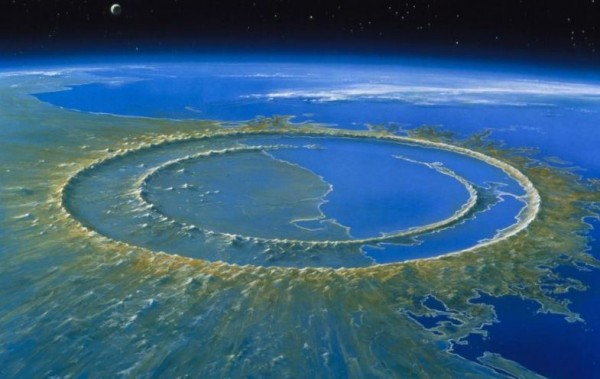Killer Asteroid that Destroyed the Dinosaurs Led to the Rise of the Human Race
| Arthur Dominic Villasanta | | May 08, 2016 11:50 AM EDT |
Chicxulub crater in the Gulf of Mexico (artist's concept).
Scientists are learning more about how life on Earth recovered after drilling into the "peak wall" of the massive Chicxulub Crater gouged into the ocean floor off the Yucatan Peninsula in Mexico. The killer asteroid destroyed the dinosaurs and 75 percent of life on Earth.
Research being undertaken by scientists and geophysicists working for the European Consortium for Ocean Research Drilling is focusing on a ring of mountains surrounding the crater left by the asteroid impact. This ring hasn't been studied yet.
Like Us on Facebook
The research should shed more light on how mammals, and eventually humans, profited from this global catastrophe.
It's generally well-accepted that a monstrous asteroid about 150 kilometers wide struck the Gulf of Mexico some 66 million years ago. This extinction event led to the demise of the dinosaurs but opened the door for other living organisms, first mammals and later humans, to take the place of the dinosaurs.
This site of this stupefying asteroid impact has since been called the Chicxulub Crater. The research team aboard the Liftboat Myrtle, a drilling platform once used to drill for oil, has now drills into rocks dating from the day the Earth was hit by the asteroid. They began drilling into the Chicxulub Crater last April.
Drilling into the peak ring should tell the scientists more about the asteroid that caused it, said Sean Gulick, a geophysicist at the University of Texas at Austin who co-leads the team with Joanna Morgan, a geophysicist at Imperial College in London and a leader of the expedition.
He said the rocks they've recovered show how life began to recover after the catastrophe. Gulick said the expedition has discovered limestone and rocks containing fossils dating from after the impact
Gulick believes the rocks from the peak ring are extremely valuable. If any microscopic organisms survived near the site of the asteroid impact, their fossils might be in these samples.
The cataclysm ended the age of the dinosaurs but the few creatures that survived went on to dominate and shape the world.
"The mammals survived," said Morgan. "And that led on to our own evolution."
TagsChicxulub crater, yucatan peninsula, Mexico, European Consortium for Ocean Research Drilling, asteroid, Liftboat Myrtle, Sean Gulick, Joanna Morgan
©2015 Chinatopix All rights reserved. Do not reproduce without permission
EDITOR'S PICKS
-

Did the Trump administration just announce plans for a trade war with ‘hostile’ China and Russia?
-

US Senate passes Taiwan travel bill slammed by China
-

As Yan Sihong’s family grieves, here are other Chinese students who went missing abroad. Some have never been found
-

Beijing blasts Western critics who ‘smear China’ with the term sharp power
-

China Envoy Seeks to Defuse Tensions With U.S. as a Trade War Brews
-

Singapore's Deputy PM Provides Bitcoin Vote of Confidence Amid China's Blanket Bans
-

China warns investors over risks in overseas virtual currency trading
-

Chinese government most trustworthy: survey
-

Kashima Antlers On Course For Back-To-Back Titles
MOST POPULAR
LATEST NEWS
Zhou Yongkang: China's Former Security Chief Sentenced to Life in Prison

China's former Chief of the Ministry of Public Security, Zhou Yongkang, has been given a life sentence after he was found guilty of abusing his office, bribery and deliberately ... Full Article
TRENDING STORY

China Pork Prices Expected to Stabilize As The Supplies Recover

Elephone P9000 Smartphone is now on Sale on Amazon India

There's a Big Chance Cliffhangers Won't Still Be Resolved When Grey's Anatomy Season 13 Returns

Supreme Court Ruled on Samsung vs Apple Dispute for Patent Infringement

Microsoft Surface Pro 5 Rumors and Release Date: What is the Latest?










